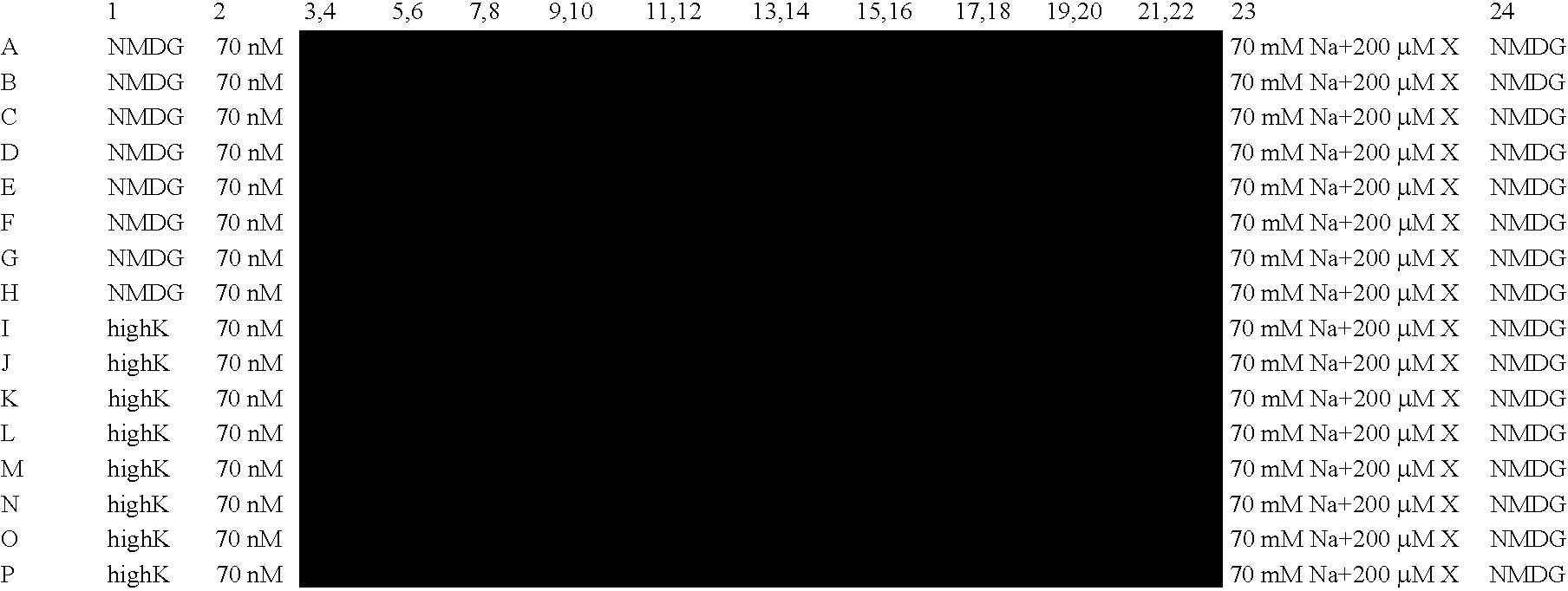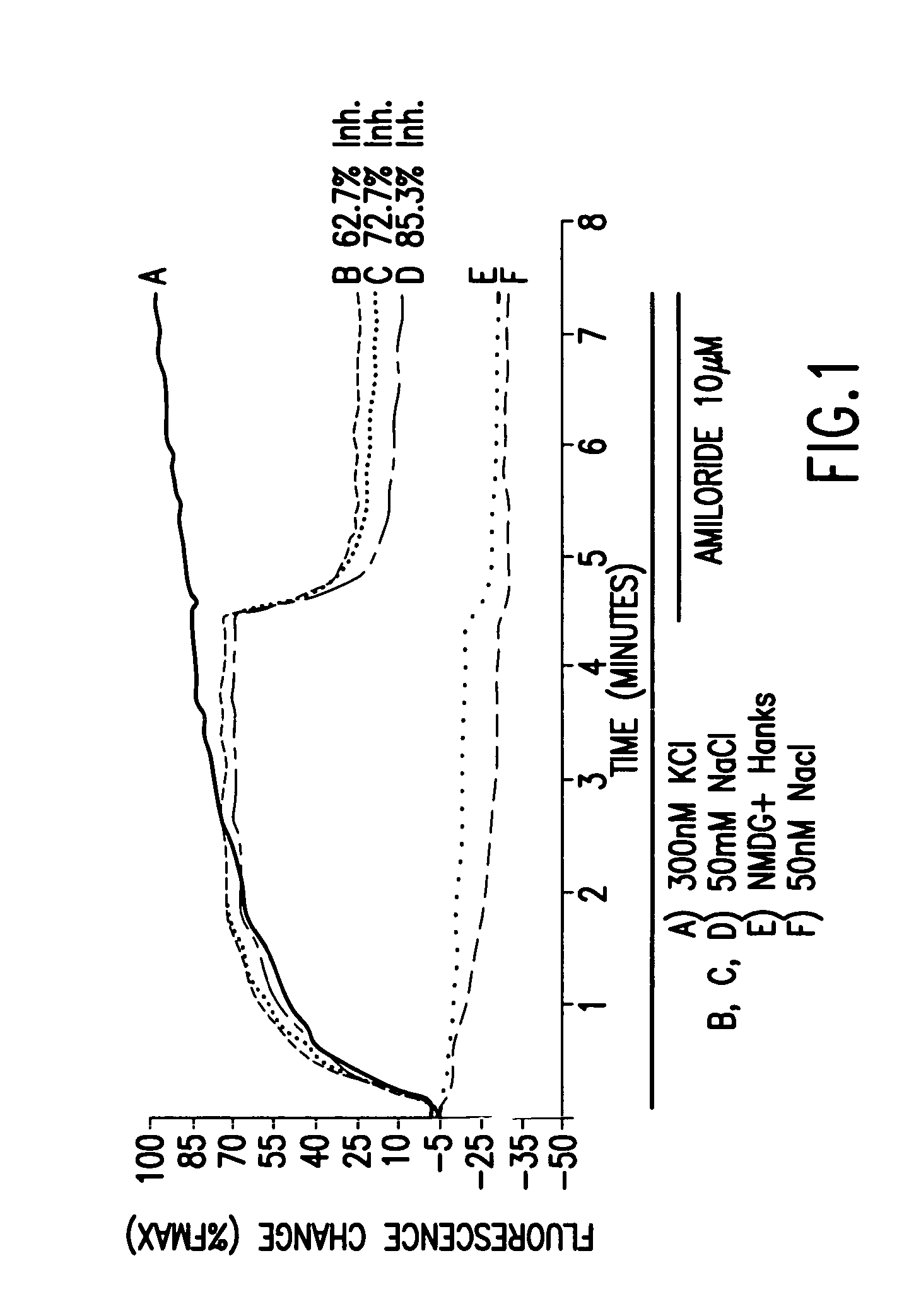Electrophysiological assay using oocytes that express human ENaC and the use phenamil to improve the effect of ENaC enhancers in assays using membrane potential reporting dyes
a technology of oocytes and enhancers, applied in the field of enac enhancers in membrane potential reporting dyes, can solve the problems of inability to record enac in i>xenopus /i>oocytes, inability to use tedious electrophysiological techniques, and inability to screen compounds at high throughpu
- Summary
- Abstract
- Description
- Claims
- Application Information
AI Technical Summary
Benefits of technology
Problems solved by technology
Method used
Image
Examples
example 1
[0159] DNA sequences encoding the alpha, beta and gamma subunit of a human ENaC expressed in human taste cells were cloned from human kidney cells by RT-PCR.
[0160] Methods for Cloning Human Epithelium Sodium Channel Subunit DNA Sequences (ENaCs)
[0161] Human ENaC cDNAs for α, β and γ ENaC were amplified from human kidney cDNA (Origene Technologies Inc.) by PCR using the following primer pairs, respectively: 5′ CGC GGA TCC GCC CAT ACC AGG TCT CAT G 3′ and 5′ CCG GAA TTC CTG CAC ATC CTT CM TCT TGC 3′; 5′ CGC GGA TCC AGC AGG TGC CAC TAT GCA C 3′ and CCG CTC GAG GTC TTG GCT GCT CAG TGA G 3′; 5° C. GC G GA TCC CCT CM AGT CCC ATC C TC G 3′ and 5′ CCG GAA TTC GAC TAG ATC TGT CTT CTC AAC 3′. The primers were designed to be complementary to 5′ and 3′-untranslated region sequence in order to retain the endogenous translation initiation signal, and they introduced terminal restriction endonuclease sites that were used to clone amplified ENaC cDNAs into the mammalian expression vector pcDNA3 (...
example 2
[0164] DNA sequences encoding the alpha, beta and gamma subunits of a human ENaC, SEQ ID 1, 2, and 3, respectively, were each cloned into the expression vector pcDNA3 to produce alpha, beta and gamma subunit plasmids that express human ENaC subunit polypeptides. HEK293T cells were transiently transfected via lipofection with 1:1:1 weight ratios of α, β, and γ subunit plasmids expressing human ENaC (2 μg of each subunit / 20 million cells). Transfected cells were plated into 384-well plates and analyzed on a VIPRII Instrument (Aurora Biosciences) using voltage-sensitive fluorescent dyes. Cells expressing ENaC exhibited a Na+ dependent fluorescence change, as compared to mock-transfected cells (FIG. 1). In FIG. 2, the Na+-dependent fluorescence change is totally abolished by Phenamil, a known ENaC antagonist. Conversely, another compound was found to increase the Na+-dependent fluorescence change but this effect is abolished by Phenamil. This compound is believed to be an ENaC enhancer,...
example 3
Improved ENaC Assay Using ENaC Inhibitor (Phenamil)
[0209] Modulation of ENaC functions is monitored in human embryonic kidney (HEK)293 cells expressing the three different ENaC subunits. HEK293 cells are transiently transfected with the ENaC subunit plasmids using lipid-based systems. Transfected HEK293 cells are seeded into 384-well screening plates and functional expression of ENaC is allowed to proceed for a total of 24 hours. Cells are then labeled with specific dyes (such as DisBac2(3) and CC2-DMPE, Panvera) allowing the detection in subtle changes in membrane potential. Changes in dye fluorescence properties, upon modulation of ENaC functions, are monitored using a Voltage-Intensity-Plate-Reader (VIPR, Panvera). Using this technology, we can detect inhibition of ENaC function (Na+-induced change in membrane potential dye fluorescence) with increasing concentration of a known ENaC inhibitor, Phenamil (FIG. 6, blue trace). On the other hand an ENaC enhancer (ID # 478354) increa...
PUM
| Property | Measurement | Unit |
|---|---|---|
| molecular weight | aaaaa | aaaaa |
| molecular weight | aaaaa | aaaaa |
| molecular weight | aaaaa | aaaaa |
Abstract
Description
Claims
Application Information
 Login to View More
Login to View More - R&D
- Intellectual Property
- Life Sciences
- Materials
- Tech Scout
- Unparalleled Data Quality
- Higher Quality Content
- 60% Fewer Hallucinations
Browse by: Latest US Patents, China's latest patents, Technical Efficacy Thesaurus, Application Domain, Technology Topic, Popular Technical Reports.
© 2025 PatSnap. All rights reserved.Legal|Privacy policy|Modern Slavery Act Transparency Statement|Sitemap|About US| Contact US: help@patsnap.com



